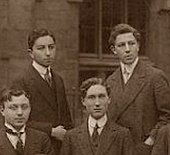Théodore Fraenkel
Théodore Fraenkel (born April 21, 1896 in Paris ; † January 25, 1964 there ) was a French doctor and writer with Russian roots. He was first among the Dadaists , then later one of the Surrealists .
Live and act
Fraenkel's parents emigrated from the Russian Empire to France in 1890 and settled in Paris. During the presidency of Émile Loubet , Fraenkel was granted French citizenship in 1904 .
In 1907 Fraenkel came to the Lycée Chaptal , where he met André Breton that same year . Based on the ancient sophists , the two founded the Sophistes Club during their school days . After completing his baccalaureate , Fraenkel applied for the “Certificat d'études, physiques, chimiques et biologiques” (PCN) in order to prepare for a degree in medicine .
During the First World War Fraenkel came to the military hospital in Nantes ( Loire-Atlantique ), where he met his school friend Breton again. Through this he made the acquaintance of Jacques Vaché , who would later serve as a model for “Théodore Letzinski” in his novella Le sanglant symbole . Fraenkel took part in the battles of September / November 1915 with the rank of medical assistant .
At the beginning of 1917 Fraenkel was able to interrupt his military service and go to Paris. There he got to know Pierre Albert-Birot and his avant-garde magazine SIC . As early as July 1917, Fraenkel was sent to Odessa as a military doctor . He returned from this mission in October of the same year, as the Russian civil war prevented a long stay.
Demobilization came soon after the Compiègne armistice and Fraenkel was able to resume his studies in Paris. In addition, he was allowed to work as a civilian doctor - due to his experience in the front hospitals.
At the beginning of 1920 Fraenkel was seen among Louis Aragon , Paul Éluard , Francis Picabia , Philippe Soupault and Tristan Tzara . During this time he wrote his first plays and staged readings with texts from his friends. In 1922 he married an immigrant Romanian, Bianca Maklès, in Paris. His wife's three sisters married three of his friends one after the other: Sylvia the writer Georges Bataille , Rose André Masson and Simone Jean Piel .
In 1922, Max Ernst painted The Rendezvous of Friends , on which he immortalized Théodore Fraenkel along with other friends.
In 1931 Bianca Fraenkel died in Carqueiranne ( Département Var ). Two years later Fraenkel married Marguerite, a daughter of the writer Julien Luchaire .
At the beginning of the civil war in Spain , Fraenkel went to Spain and joined the Republicans . In 1939 he returned to France. His credo “never again war” ended when he joined the Resistance to fight against the German occupation . The liberation from National Socialism and the war experienced Fraenkel with the rank of lieutenant-colonel .
On September 6, 1960 Fraenkel was one of the signatories of the 121st manifesto .
Although he knew about the problems as a doctor, he neglected his high blood pressure and died on January 25, 1964 of a cerebral haemorrhage . At his personal request, he was buried anonymously without ceremony in the cemetery of Thiais ( Val-de-Marne ) .
literature
- Adam Biro, René Passeron (eds.): Dictionnaire général du surréalisme et de ses environs . PUF, Paris 1982, ISBN 2-13-037280-5 .
- Stuart Kendall: Georges Bataille . Reaction Books, London 2007, ISBN 978-1-86189-327-7 , pp. 63-64.
- Laurent Le Bon (Ed.): Dada . Éditions du Center Pompidou, Paris 2005, ISBN 2-84426-277-5 (also catalog of the exhibition of the same name, Center Georges-Pompidou , October 5, 2005 to January 9, 2006).
- Cedric Meletta: Jean Luchaire. L'enfant perdu des années sombres . Perrin, Paris 2013, ISBN 978-2-262-03437-5 .
Individual evidence
- ↑ located in the 8th arrondissement of Paris.
- ↑ She later achieved success as an actress under the pseudonym Lucienne Morand .
- ↑ in second marriage then Jacques Lacan .
| personal data | |
|---|---|
| SURNAME | Fraenkel, Théodore |
| BRIEF DESCRIPTION | French doctor and writer |
| DATE OF BIRTH | April 21, 1896 |
| PLACE OF BIRTH | Paris |
| DATE OF DEATH | January 25, 1964 |
| Place of death | Paris |

